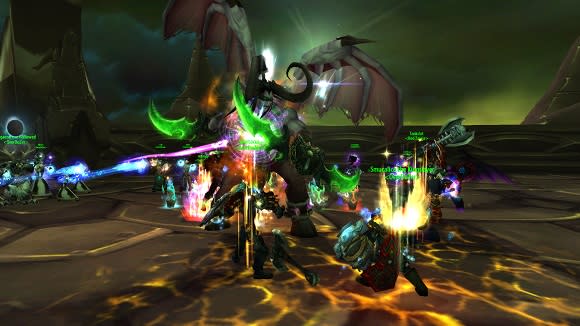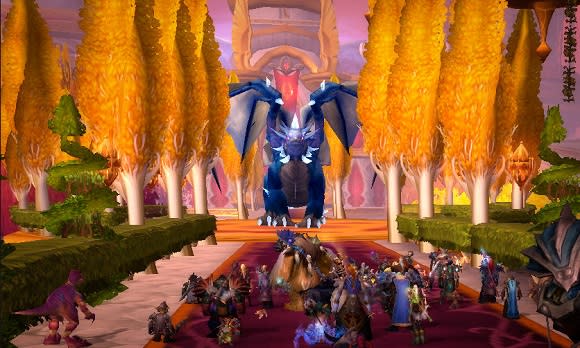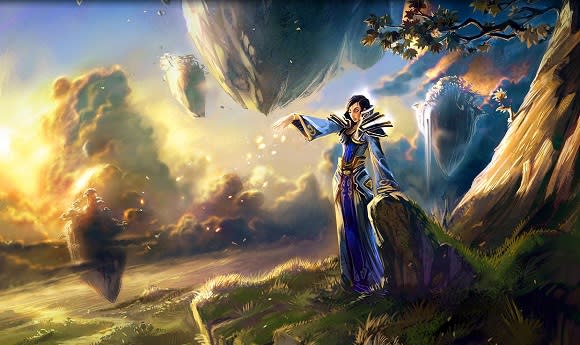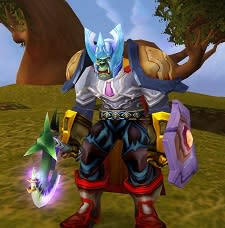WoW Archivist: Warlords of Draenor hates The Burning Crusade
WoW Archivist is a biweekly column by WoW Insider's Scott Andrews, who explores the secrets of World of Warcraft's past. What did the game look like years ago? Who is etched into WoW's history? What secrets does the game still hold? It first appeared on our sister site on March 28th and is included here by permission.
In many ways, The Burning Crusade was the birth of modern WoW. Most of TBC's innovations are still going strong in WoW today and have been ever since their introduction. Looking back, I find it's striking how many key features of WoW were absent in classic, unveiled only during the game's first expansion.
Even more striking, however, is how many of these innovations Warlords of Draenor seems poised to undo. Just as Garrosh will undo the transformation of Draenor into Outland, Warlords seeks to unravel most of what Blizzard innovated during TBC. The next expansion will take us through a portal into a very different WoW.
Archivist has covered all the major patches of The Burning Crusade: patch 2.0.1, patch 2.0.3, patch 2.1, patch 2.2, patch 2.3, and patch 2.4. Now it's time to review the expansion as a whole -- and explore how Warlords will make most of TBC's innovations disappear into the nether.
Dawn of the quest hub
The idea seems so obvious it's hard to imagine that classic WoW actually didn't have quest hubs, at least not in the strict sense. WoW was the first MMO to promote the idea of leveling mainly through quests rather than grinding mobs. So Blizzard had no model to look at when it was designing the original quests.
In classic WoW, quests were put into the game wherever the developers thought they made sense, mostly from a lore perspective. Quests didn't necessarily guide you through a zone area by area. Quests were scattered, and their objectives were, too. They weren't breadcrumbs; they were meant to be discovered. They didn't hold your hand; they sent you on an adventure, like it or not.
In Outland, players discovered a much more guided questing experience. You arrived at a town or location, picked up a number of quests, completed them and any followups, and then one more quest sent you to the next hub. It's a formula that worked so well that Blizzard used it not just in the following three expansions but in ther complete overhaul of the Old World as well.
But in Warlords... Blizzard likes how the Timeless Isle worked out in Mists of Pandaria. The island features more dynamic content. It rewards exploration rather than bread-crumbing us through a series of quests. Players have more opportunities for adventure and less hand-holding. In that way, Warlords could actually take us back to a more classic WoW questing experience.

Friendly skies
The moment they first took to the skies was a special one for many players. We were no longer bound to the surface. You could fly over all the enemies on your way to that khorium node instead of riding through them and hoping that none of them dazed you. It was the ultimate freedom, and you could explore Outland's incredible vistas at your whim.
Flying was also the key to opening up near areas and content. If you wanted to farm motes on the Elemental Plateau or catch the elusive Mr. Pinchy, you needed a ride with wings.
But in Warlords... It's no secret that Blizzard has been ambivalent about flying for a long time. Flying allows players to skip content and takes the risk out of exploration. For both Wrath of the Lich King and Mists of Pandaria, Blizzard didn't allow us to fly in the expansions' zones until players had reached a certain threshold.
Now Blizzard is weighing whether it ever ever wants players to fly on Draenor.
Daily planet
Dailies have been the focus of solo play at the level cap for so long that it's difficult to imagine WoW without them. But it's true: Vanilla WoW had no daily quests.
The Burning Crusade introduced dailies for nearly every aspect of the game: reputation, professions, world PvP, battlegrounds, dungeons, and "valor" (they were known as badges at the time). Dailies drove the entire Shattered Sun Offensive event, the climax of the expansion. Many players look back on that event as the most successful in WoW's history.
Dailies were such a home run that Blizzard began to lean on them as their go-to content for anything and everything. It worked, for the most part, until Mists of Pandaria went way over the top with daily content at level 90.
But in Warlords... Blizzard has heard our complaints about dailies receiving too much focus at endgame. Warlords will still have dailies, but dailies won't be as all-consuming as in past expansions. They won't be the "primary focus," according to Bashiok.

Merit badges
Prior to TBC, outside of a few rare quest lines, you had exactly one way to acquire raid-level gear: raiding. If you didn't get the drops you wanted, you had no recourse. TBC changed all that with an item called Badge of Justice. Badges dropped from heroic dungeon and raid bosses. They could be exchanged for armor, weapons, trinkets, resistance gear, crafting items, and epic gems.
Blizzard evolved badges from an item to a more malleable points-based system that we've used now for the last three expansions. The idea behind it, however, has remained the same.
But in Warlords... Blizzard has pointed to the Lesser Charms of Mists and the extra rolls they provide as the main way of acquiring extra gear in the future. The devs have said that justice and valor points may disappear entirely. Instead, Blizzard wants to make the bonus rolls smarter to account for gear that you already have.
Numbers game
The 40-player raids of classic WoW gave way to a limit of 25. Certainly this was an easier number to manage for most officers and raid leaders, but many guilds found it to be a tough transition. It didn't help that Tier 4's Karazhan could be run by only 10 players at a time.
Classic WoW had more than 40-player raids, however. Zul'Gurub and the Ruins of Ahn'Qiraj both had a 20-player limit, and Upper Blackrock Spire (which most didn't even consider a "raid" in the strict sense) eventually maxed out at 10 (down from 15). So yes, classic's endgame was not as organized as people tend to think. The sizes were a bit scattered and arbitrary.
TBC put an end to all that. Raid sizes stabilized at 25 and 10 and have remained so for four expansions.
But in Warlords... The concept of raid sizes will no longer apply to most raiding content. All but mythic raids will be flexible in their size. Hard-mode raiding will require 20 players instead of 25. Groups of 10 players will be the new minimum, but never a maximum.

Except Warlords loves arenas
The Burning Crusade also introduced arenas, a small-scale form of deathmatch PvP, as a more nuanced contrast to the tactics of battlegrounds. During that era, players could engage in skirmishes, which were unranked arena matches free of ratings, and thus free of consequence. Players could try out different comps or builds or just give check out what arena PvP is like without risk.
Though the audience remains a niche one, arena matches have endured throughout WoW's history ever since.
And in Warlords... Not only will arenas continue, they will be better than ever. Blizzard plans to add a spectator mode, and skirmishes will return.
Out-world problems
Of course, The Burning Crusade had its share of problems to match its improved feature set:
The clown suit: Blizzard designed many different looks for items without really creating a cohesive style. Players who equipped the best items they could often wound up dressed in a hideous mishmash of colors and themes that's become known as the "clown suit" look. In a world without transmog, this was a genuine problem.
Attunements: It's a horse that's been beaten to death, rezzed, and beaten to death again so many times that it's hardly worth mentioning at this point. But it's true: The Burning Crusade's insane attunements made designing and assembling your own working space shuttle look easier than zoning into the Battle for Mount Hyjal.
Inaccessible raiding: TBC raids basically had only hard modes. Some bosses were easier than others, but raids were designed to require dedication and a coordinated guild effort to overcome. During most of the expansion, it was very difficult for someone just hitting the level cap to get the attunements and gear he needed to even apply for a raiding guild. And even then, if you weren't the right class or spec, you didn't have much of a chance anyway. That leads me to...
Class and profession stacking: By Sunwell, raiders had figured out which specs brought the most utility and throughput, and the difficulty of those bosses pushed guilds to use every advantage possible. A raid full of resto Shamans and leatherworkers (for Bloodlust drums) became the path of least resistance, and that's what the top end raiding guilds aimed for. Players who lost their raiding slots because they didn't choose the right class or spec -- most infamously, Mages -- called it "getting sunwelled."
Trash: Blizzard put so much trash in raids that forums threads constantly popped up to complain about it. Hyjal was the most egregious case, with its waves of trash mobs that had to be defeated prior to every boss attempt. But Karazhan, Serpentshrine, and Tempest Keep all required many pulls to clear to a boss. Heroic dungeons such as Shadow Labyrinth and Shattered Halls also had lots and lots of trash. Trash could respawn as quickly as 45 or even 25 minutes. During this time, Tigole described trash as "equally interesting yet non-epic-dropping non-bosses." Players were not amused. But at least he said that while announcing that respawn timers would be relaxed.
Arena-driven nerfs: Arenas were a new thing -- Blizzard had not designed its classes to compete in these intense, 2 on 2 situations. Thus, many adjustments had to be made to preserve a semblance of balance among the specs. Most of those adjustments came in the form of nerfs. Many players who didn't PvP ended up hating arenas because arena nerfs directly affected their performance in other areas of the game.
Legendaries as drops: In classic WoW, Blizzard required the completion of quest lines to earn a legendary in addition to a lucky drop. In The Burning Crusade, legendaries dropped straight from bosses, and this led to loot drama.
Garrosh: Enough said.
But nearly all of these issues have been corrected already. Blizzard paid attention to what made players unhappy in TBC. By the end of Wrath, most of these issues had been addressed.

Despite these issues, TBC was an absolute smash success for Blizzard. The playerbase grew tremendously during this expansion. Most players remember the era with great fondness. After all, we got to take on some of Warcraft's biggest, baddest bad guys, such as Kael'thas, Zul'jin, Archimonde, Illidan, and Kil'jaeden. Draenei and blood elves remain popular races and brought fantastic new lore to the storyline. Paladins and Shamans "crossing the aisle" was an important step toward balancing the factions in both PvE and PvP. Finally, Outland is an extraordinary place. Nowhere we've been has ever felt so foreign compared to Azeroth's original questing zones. We're all hoping that Draenor will treat us to an equally compelling, equally alien landscape.
It has taken Blizzard six years, but Warlords will move us past all of the TBC features that Blizzard has leaned on so heavily for the past four expansions. I see this as a good thing for the game. The TBC systems vastly improved on classic WoW's, but most of them have run their course. Just as TBC was an aggressive evolution for WoW, Warlords could be its next transformation.

WoW Archivist is a column by WoW Insider's Scott Andrews; it runs on Massively by permission. Every other weekend, Scott explores the secrets of World of Warcraft's past. What did the game look like years ago? Who is etched into WoW's history? What secrets does the game still hold?



